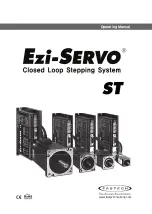
DRIVE SETUP
84
the elevator brake, and observe any car
motion. When the car comes to a stop,
the observation is complete, set the
brake and stop the drive, again through
normal control channels. Do so and
observe that...
a) The contactor picks, and the
drive does start.
b) There may be some initial
upward motion, but the car
should return to its original
position within a second or so.
c) When motion is halted, there will
be motor armature current
producing torque holding the
car. This can be observed at
#611 on the local display or a
separate DC clamp-on
ammeter, if available.
d) Set the brake and turn the drive
OFF via normal commands. (In
that order, to prevent the car
from drifting away!)
4. Repeat #3 several times and.....
a) Increase the setting of #131
(ARB Bandwidth) to reduce the
amount of initial movement as
desired. But there may be more
jerkiness. Reducing the setting
of #131 will allow more
movement, but with less jerk.
Adjust #131 for a good
compromise.
b) Reduce the setting of #132
(ARB Damping) to speed up the
position recovery, or increase
the setting for a softer recovery,
as desired.
c) If oscillations occur, release the
brake and shut down the drive
or reduce the setting of #131 to
stop them. This may be a
practical limit for position
tightness in this particular
hoistway. See the hints below
for using the notch filter.
5. Change the reference velocity to run the
car at normal speeds. Make several
empty single or multiple floor runs up
and down to observe the complete
starting action. The adjustments made
so far should not alter landing position
accuracy. Ride the car to observe the
quality of adjustment.
6. If weights are available, load the car to
payload capacity. Repeat the
observations and adjustments of #4 with
a full load. In this case the initial
movement should be downward. Then
repeat floor runs as in #5 with a full load.
Ride the car to verify smoothness.
Adjustment procedure is complete.
ARB Adjustment Hints And Cautions
1. Caution the ARB function can increase
regulator bandwidth far beyond that
required for controlling the speed of the
elevator. It does so at only near zero
speed, but when the ARB gain
bandwidth is boosted it is possible that
one or more mechanical resonant
frequencies may become excited to
produce unacceptable vibration. If an
annoying vibration does occur, try to
determine the resonant frequency.
Then use the notch filter to tune it out if
possible. Be aware that the notch filter
does cause additional phase shift lag.
This can and will interfere with the
operation of E-Reg and ARB. Tune the
notch filter to the resonant frequency
and adjust notch depth to the smallest
value that suppresses the vibration.
Then turn ARB off and verify or re-tune
E-Reg to yield acceptable performance.
Then re-tune ARB settings to control
rollback. Some hoist ways may not be
compatible with high gain ARB settings.
2. The adjustment settings for Speed
Bandwidth, Per-Unit Inertia, and
Stiffness #40, 41, & 42 are used by both
the velocity regulator (E-Reg) and the
velocity control portion of ARB, therefore
adjustment of #40, #41, & #42 will alter
the performance of anti-rollback
controls. A high setting for Stiffness #42
will help the velocity control respond to
changes in load but will cause longer
settling times for both velocity and ARB
position regulation. Be sure to tune the
velocity controls of the elevator
BEFORE adjusting controls for ARB
Bandwidth and Damping, #131 & #132.
Changing any ARB settings, #130 -
#133, will not interfere with other
velocity control tuning.
3. Elevator rollback is a function of gravity
load unbalance of the car. This is what
causes the car to move when the brake
is released, even though the reference
velocity may still be at zero. However,
Содержание DSD 412
Страница 1: ...DSD 412 DC Elevator Drive Technical Manual CS00407 rev 06...
Страница 6: ...6...
Страница 102: ...MAINTENANCE 102 Figure 24 Connector and E prom Locations...
Страница 103: ...MAINTENANCE 103 Figure 25 Test Point Locations...
Страница 115: ...OUTLINE DRAWING 100A 115 Figure 26 Drive Chassis Outline DSD 412 100 Amp...
Страница 116: ...OUTLINE DRAWING 190A 116 Figure 27 Drive Chassis Outline DSD 412 195 Amp...
Страница 117: ...OUTLINE DRAWING 300A 117 Figure 28 Drive Chasis Outline DSD 412 300 Amp...
Страница 118: ...LAYOUT DRAWING 100A 118 Figure 29 Layout DSD 412 100 Amp A3 A1 A2 A2 L1 NEG GND L2 L3 POS...
Страница 119: ...LAYOUT DRAWING 195A 119 Figure 30 Layout DSD 412 195 Amp A3 A1 A2 A2...
Страница 120: ...LAYOUT DRAWING 300A 120 Figure 31 Layout DSD 412 300 Amp A3 A1 A2 A2...
Страница 121: ......
















































